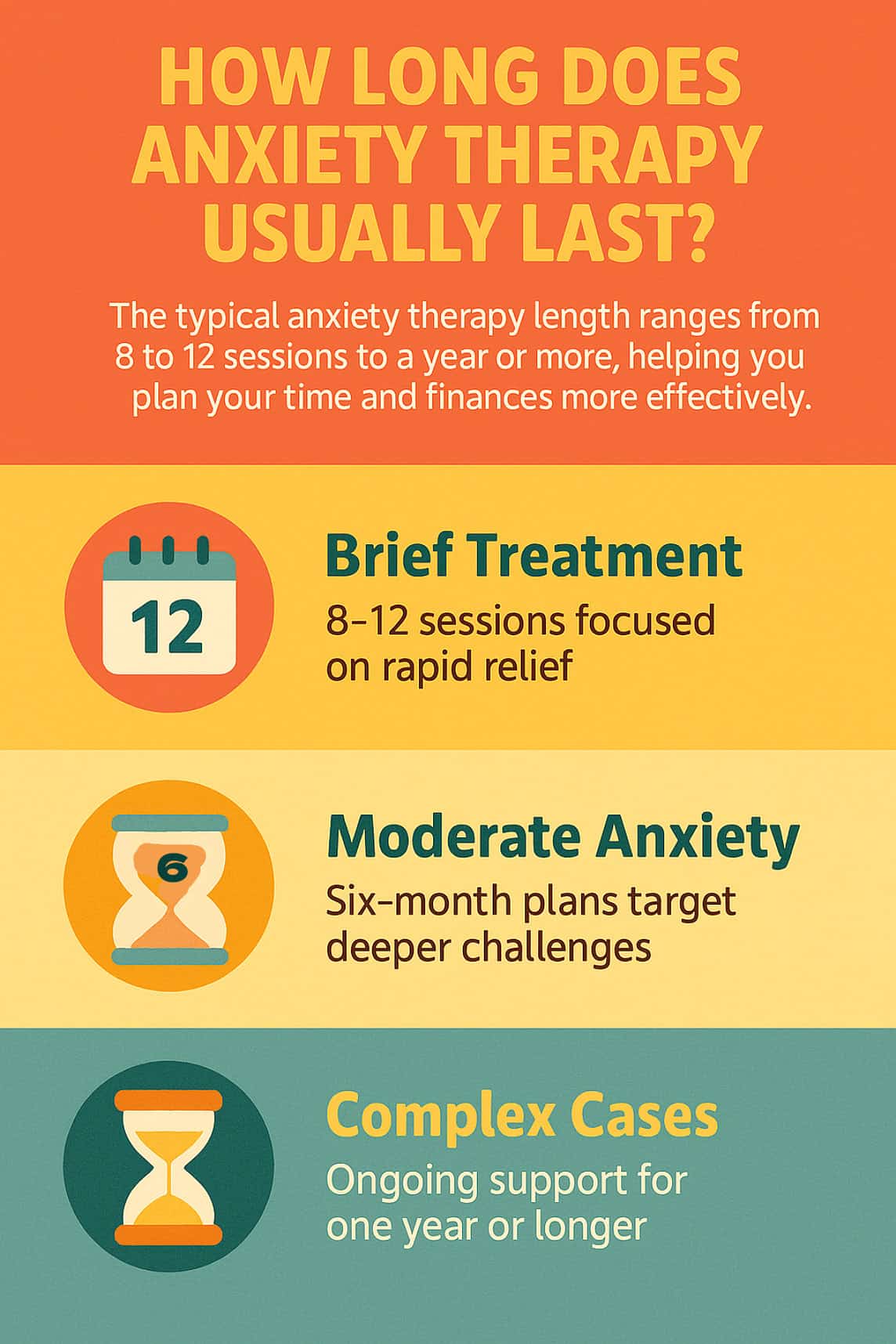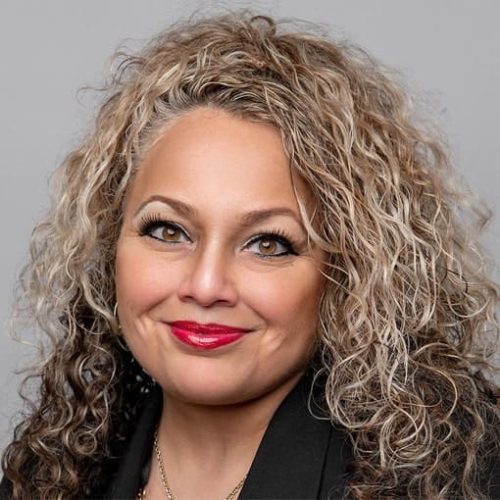
Key Takeaways for Anxiety Therapy Length.
- Brief therapy plans usually last 8–12 sessions and are ideal for specific or mild anxiety.
- Moderate anxiety often requires 3–6 months of regular weekly or bi-weekly sessions.
- Complex cases (such as anxiety with addiction or trauma) may benefit from year-long therapy with tapering sessions.
- Session frequency typically starts weekly and reduces as coping skills improve.
- Ongoing booster sessions help maintain progress and reduce relapse risk.
- Daily skill practice and lifestyle changes between sessions can shorten the overall length of therapy.
- Budgeting for time and finances ensures therapy remains consistent and sustainable.
🎯 Knowing what to expect helps you plan smarter and stay committed to recovery.
👉 Ready to take the next step? Learn more about anxiety therapy at AERCS and how to book your free 15-minute phone consultation.

Most clients find that the anxiety therapy length for a standard treatment plan runs about eight to twelve weekly sessions, while more complex anxiety, especially when paired with substance use or long-standing trauma, may need six to twelve months of work with sessions tapering from weekly to monthly maintenance check-ins. Knowing this timeline helps you budget both time and money, and it prevents the frustration that can derail recovery plans.
Why Therapy Duration Varies.
Factors That Shape Your Timeline.
- Severity of Symptoms, mild social worry often resolves faster than years of panic attacks.
- Co-occurring Issues, addiction, depression, or trauma usually add sessions.
- Commitment to Homework, practising skills between visits speeds progress.
- Life Stressors, job loss or caregiving can lengthen treatment because new triggers emerge.
Quick Stat.
A recent Canadian study found that clients who completed a full CBT program in 10 to 12 sessions reported a 55% drop in anxiety scores, while those who skipped homework needed roughly four extra sessions for similar gains.
Understanding Brief Therapy Models (8–12 Sessions).
What a Short Plan Looks Like.
- Sessions 1–2, assessment, goal setting, and basic grounding skills.
- Sessions 3–6, cognitive restructuring and exposure exercises.
- Sessions 7–8, relapse prevention strategies.
- Sessions 9–12, review, taper planning, and aftercare options.
Ideal for.
- Specific phobias, performance anxiety, or mild health anxiety.
- Clients who do daily homework and attend every week.
Cost and Time Snapshot.
- Eight to twelve hours of direct therapy.
- Home practice adds ten minutes a day.
- Often completed in two to three months.
Extended Therapy Plans (3–6 Months).
When Longer Care Makes Sense.
- Generalised anxiety with constant rumination.
- Panic disorder with agoraphobia.
- Social anxiety linked to childhood bullying or shyness.
What to Expect.
| Month | Focus | Session Frequency |
|---|---|---|
| 1 | Skill building and exposure planning | Weekly |
| 2 | Midpoint review and deeper exposures | Weekly |
| 3–4 | Fine-tuning skills, adding ACT or mindfulness | Bi-weekly |
| 5–6 | Taper to monthly, relapse monitoring | Monthly |
By month six, many clients report stable anxiety levels and have a clear self-care routine in place.
Year-Long and Maintenance Care.
Who Benefits.
- People managing anxiety plus substance use recovery.
- Clients with complex trauma or chronic health conditions.
- Those who experience high-pressure careers where new stressors appear often.
Typical Structure.
- First three months, weekly sessions establish safety and core skills.
- Next three months, bi-weekly to reinforce and adapt tools.
- Final six months, monthly or quarterly booster sessions to prevent setbacks.
Monthly boosters catch early relapse signs, whether that means rising anxiety or urges to self-medicate.
How Tapering Works.
- Symptom Scores Drop, therapist suggests moving from weekly to bi-weekly.
- Skills Check, demonstrate that you can calm yourself without help.
- Set a Booster Date, schedule a follow-up in four to eight weeks.
- Return as Needed, life events may call for refresher sessions.
Tapering saves money, keeps gains fresh, and respects your busy schedule.
Maximising Progress Between Sessions.
- Daily Practice, ten minutes of breathing, thought logs, or exposure homework.
- Healthy Substitutions, swap evening drinks for a thirty-minute walk.
- Progress Tracking, use a 0–10 anxiety scale in a phone app.
- Community Support, join a peer group or trusted friend check-in.
Clients who follow these steps often finish therapy two to three sessions sooner than those who rely solely on the therapy hour.
Budgeting Time and Money in Dufferin and the GTA.
Average Fees in Ontario.
- Registered psychotherapist: $220–$260 per session.
- Psychologist or clinical counsellor: $260–$290 per session.
Insurance Tips.
- Many extended health plans cover $500 to $1,000 annually.
- Ask if video sessions are reimbursed at the same rate as in-person visits.
Planning ahead ensures you do not run out of coverage before treatment goals are met.
Therapy Can Resolve Targeted Anxieties.
The anxiety therapy length you need depends on symptom severity, personal commitment, and any co-occurring challenges. Brief therapy can resolve targeted worries in eight to twelve sessions, moderate anxiety often needs three to six months, and complex cases may benefit from a year of tapered support. Whatever your path, steady attendance and daily skill practice shorten the journey.
Ready to map out your personalised timeline? Visit our Anxiety Therapy page and book your complimentary 15-minute phone consultation. I am here to help you plan a therapy schedule that fits your life and budget.
How many sessions make up a typical anxiety therapy length?
A standard anxiety therapy length often runs eight to twelve sessions for mild cases.
Can the anxiety therapy length be shorter if I do more homework?
Yes, diligent daily practice can reduce the anxiety therapy length by a few sessions.
What extends the anxiety therapy length beyond six months?
Co-occurring addiction, complex trauma, or inconsistent attendance usually increase the anxiety therapy length.
Does insurance affect the anxiety therapy length I choose?
Insurance limits can influence session frequency, so knowing your coverage helps tailor the anxiety therapy length.
Are booster sessions part of the anxiety therapy length?
Booster sessions count as maintenance and keep the anxiety therapy length flexible for future stressors.
Do You Need Anxiety Therapy?
Take this quick self-assessment to see if anxiety therapy could help you manage symptoms.Note: This questionnaire is educational only and does not replace a clinical assessment. If you wish to obtain professional guidance, please follow up with a licensed mental health professional.

